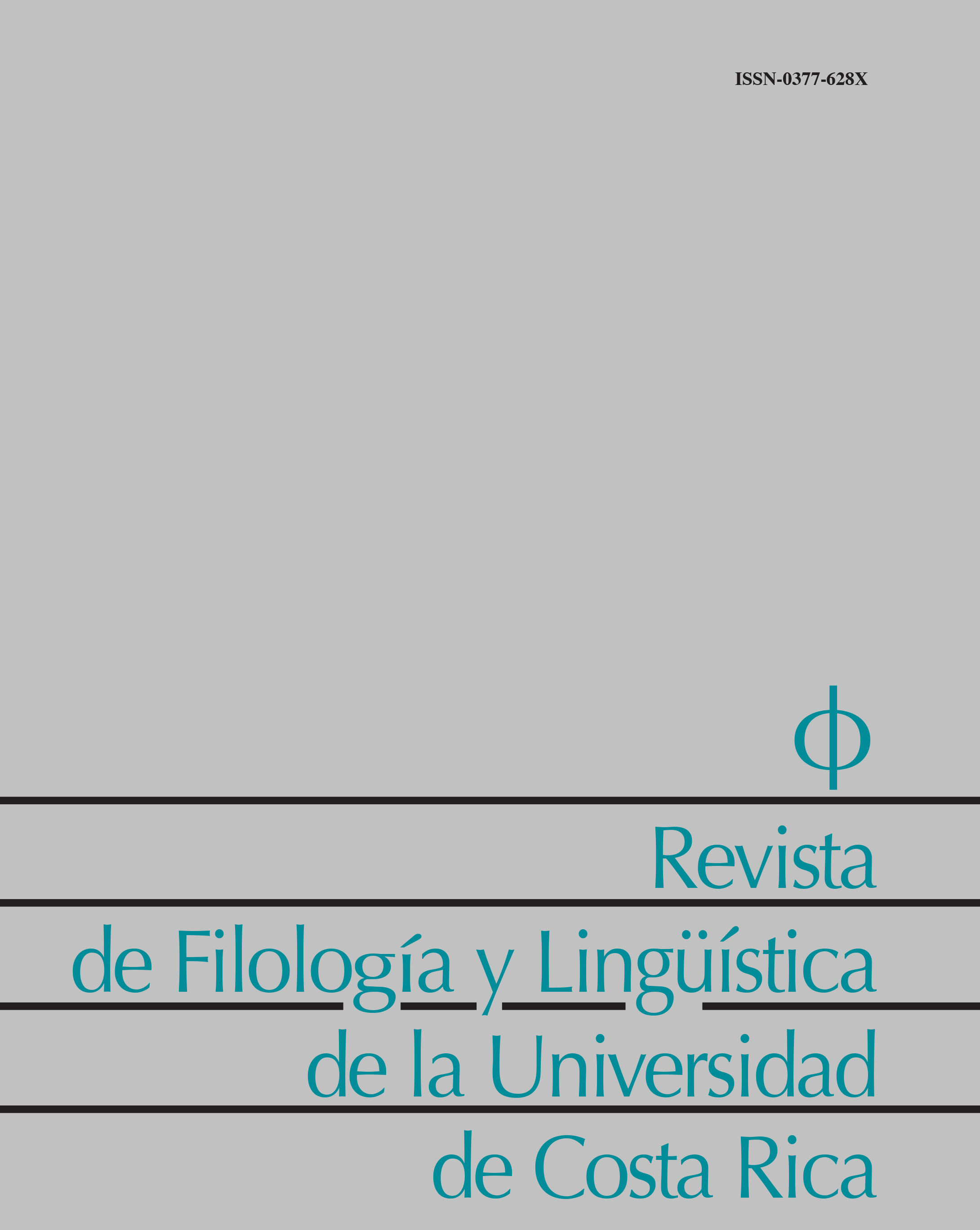Abstract
This work addresses so-called marginal clitics, clitics that are part of several verbal idioms (jorobarla ‘to spoil something’, tomarla ‘to get angry with someone’, pirárselas ‘to leave quickly’, jugársela ‘to risk’), concentrating on two aspects of their grammar: their meaning contribution and their tendency to occur as feminine forms. It is argued that in both cases the answer relates to the presence of a silent noun of manner whose semantic contribution is perceptible despite the idiomatic nature of the construction: the clitic pronominalises features of this noun, under very specific conditions that are not exclusive of this type of constructions.
References
Acedo-Matellán, V. (2010). Argument structure and the syntax-morphology interface. (Tesis doctoral). Universitat Autònoma de Barcelona.
Acedo-Matellán, V. y Mateu, J. (2014). From syntax to roots. En A. Alexiadou, H. Borer y F. Schäfer (Eds.). The syntax of roots and the roots of syntax. (pp. 14-32). Oxford: Oxford University Press.
ASALE [Asociación de Academias de la Lengua Española]. (2010). Diccionario de Americanismos. Madrid: Santillana.
Biberauer, T. (Ed.). (2008). The limits of syntactic variation. Amsterdam: John Benjamins.
Bibis, N. y Roberge, Y. (2004). Marginal clitics. Lingua. 114, 1015-1034.
Bibis, N. (2002). The syntax of clitics in idiomatic and other fixed expressions. (Tesis doctoral). University of Toronto.
Borer, H. (Ed.). (1986). The syntax of pronominal clitics. New York: Academic Press.
Brucart, J. M., Gavarró, A. y Solá, J. (Eds.). (2009). Merging features. Oxford: Oxford University Press.
Chomsky, N. (1995). The Minimalist Program. Cambridge (Mass.): MIT Press.
Cifuentes Honrubia, J. L. (2017). El complemento directo lexicalizado. Congreso morfología y sintaxis (17 y 18 de julio de 2017). Universitat de Girona.
Cordero Monge, S. y Leoni de León, J. A. (2017). Locuciones verbales con clítico: ejemplos del español de Costa Rica. Actualizaciones en Comunicación Social. 1, 152-155.
Davies, M. (s.f.). Corpus del español. Recuperado de www.corpusdelespanol.org
Espinal, M. T. (2009). Clitic incorporation and abstract semantic objects in idiomatic constructions. Linguistics. 47, 1221-1271.
Fernández Soriano, O. y Táboas, S. (1999). Construcciones impersonales no reflejas. En I. Bosque y V. Demonte (Eds.). Gramática descriptiva de la lengua española. (pp. 1723-1779). Madrid: Espasa.
Harley, H y Folli, R. (2008). Teleology and animacy in external arguments. Lingua. 118, 190-202.
Horvath, J. y Siloni, T. (2009). Hebrew idioms. Brill’s Annual Journal of Afroasiatic Languages and Linguistics. 1, 283-310.
Horvath, J., Klunover, H., Siloni, T. y Wexler, K. (en prensa). Idiom storage and the lexicon. Journal of Linguistics.
García Page, M. (2008). Introducción a la fraseología española. Barcelona: Anthropos.
García Page, M. (2010). Locuciones verbales con clítico en español del tipo dársela. Verba Hispánica. 18, 135-145.
Jaeggli, O. (1986). Three issues in the syntax of clitics. En H. Borer (Ed.). The syntax of pronominal clitics. (pp. 15-42). New York: Academic Press.
Kayne, R. S. (2004). Here and there. En C. Leclère, E. Laporte, M. Piot y M. Silberztein (Eds.). Syntax, Lexis and Lexicon-Grammar. (pp. 253-273). Amsterdam: John Benjamins.
Kayne, R. S. (2005). Movement and silence. Oxford: Oxford University Press.
Kayne, R. S. (2005a). “A note on the syntax of quantity in English”. En Kayne: 176-215.
Kayne, R. S. (2005b). “Silent years, silent hours”. En Kayne: 241-261.
Kayne, R. S. (2007). Several, few and many. Lingua. 117, 832-858.
Kayne, R. S. (2008). Expletives, datives and the tension between morphology and syntax. En T. Biberauer (Ed.). The limits of syntactic variation. (pp. 175-217). Amsterdam: John Benjamins.
Kayne, R. S. (2009). Some silent first person plurals. En J. M. Brucart, A. Gavarró y J. Solá (Eds.). Merging features. (PP. 276-292). Oxford: Oxford University Press.
Langacker, R. (2000). Grammar and conceptualization. Berlin: De Gruyter.
Leivada, E. y Grohmann, K. (2014). Clitics in idioms: properties of morphosyntax and reference. Lingua. 150, 45-70.
Leonetti, M. (2008). Specificity in clitic marking and in differential object marking. Probus. 20, 33-66.
Martín García, J. (2008). Verbos denominales en -ear: caracterización léxico-sintáctica. Revista española de lingüística. 37, 279-310.
Marantz, A. (1984). On the nature of grammatical relations. Cambridge (Mass.): MIT Press.
McGuinnis, M. (2002). On the systematic aspect of idioms. Linguistic Inquiry. 33, 665-672.
Mendívil, J. L. (1999). Las palabras disgregadas. Sintaxis de las expresiones idiomáticas y los predicados complejos. Zaragoza: Prensas Universitarias de Zaragoza.
Mishani-Uval, Y. y Siloni, T. (2016). Ditransitive idioms in Hebrew. Natural Language and Linguistic Theory. 35, 715-749.
Oltra-Massuet, I. y Castroviejo, E. (2014). A syntactic approach to the morpho-semantic variation of -ear. Lingua. 151, 120-141.
Ormazábal, J. y Romero, J. (2013). Object clitics, agreement and dialectal variation. Probus. 25, 301-344.
RAE y ASALE. (2009). Nueva gramática de la lengua española. Madrid: Espasa.
Ramchand, G. (2008). First Phase Syntax. Cambridge: Cambridge University Press.
Ruiz Gurillo, L. (1997). Aspectos de fraseología teórica. Valencia: Universitat de València.
Ruiz Gurillo, L. (2009). Liarla parda o la convencionalización de una unidad fraseológica. Español Actual. 91, 167-170.
Silva Garcés, J. (2017). Clíticos marginales en verbos denominales en -ear. Quintú Quimün. 1, 34-60.
Uriagereka, J. (1995). Aspects of the syntax of clitic placement in Western Romance. Linguistic Inquiry. 26, 79-123.
Zdrojewski, P. y Sánchez, L. (2014). Variation in accusative clitic doubling across three Spanish dialects. Lingua. 151, 162-176.

